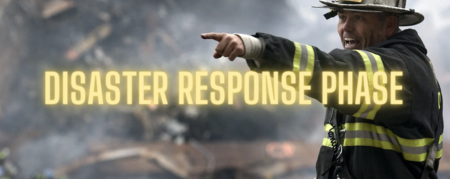Building Safety Month: Disaster Response Phase
Week three of Building Safety Month is ‘Understanding the Four Phases of Emergency Management”. Even though there are many distinct types of natural and manmade hazards, they have a common element that can allow you to prepare and protect yourself from disasters.
Most emergency managers think of disasters as recurring events with four phases: Mitigation, Preparedness, Response, and Recovery. A community should be in at least one phase of emergency management at any time.
Disaster Response Phase
The Response phase occurs during and immediately after a disaster. This is when you enact your safety plans from the Preparedness phase. The most significant goal of the Response phase is to ensure that people are out of harm’s way. Community organizations must focus on the immediate threat to people and property, including infrastructure. The safety and well-being of a community depends largely on the details and success of the preparations and plans from the Preparedness phase.
During a disaster, the single most important thing is for people to get to safety or shelter. Containment of the disaster areas and not letting it spread, is a close second. Public Safety agencies will dedicate most of their efforts to these two objectives followed by protecting property and businesses.
Once the immediate threat has passed, efforts will focus on search and rescue, damage assessment, and restoration of basic services, such as water, sanitation and electricity. Finding shelter for those whose homes were destroyed or damaged. Access to communication systems (including the Internet!) may be hampered, destroyed or even restricted for official use. Individuals and businesses may have to deal with shortages, building closures, short business hours and travel restrictions due to damage or lack of resources. Being prepared for these and remaining flexible to change will be the action plan for the day.
Towards the end of the Response phase, while the details of the disaster are still fresh in the minds of the community, lessons learned of what worked and what did not should be compiled. Most communities will need to begin the planning of reconstruction of damaged properties and infrastructure.
In most communities there are plans for saving lives and property during a disaster. Ready.gov also has some guidelines for helping others on their website.
Click here to go back to the Building Safety Month web page!
